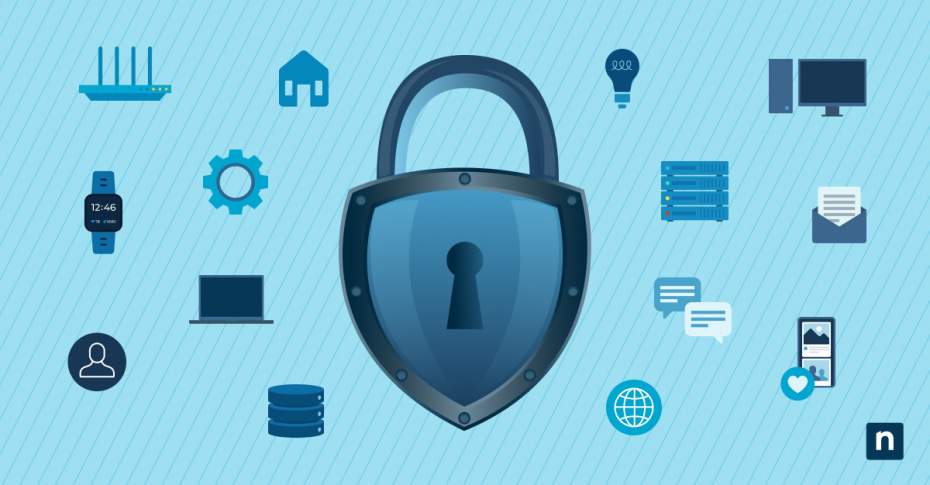Internet of Things (IoT) devices, computing devices that send and receive information via the Internet and that run very specific applications, can be anything from smart thermostats to smart TVs. The main advantage of these devices is their constant connectivity, which allows users to access information and control the devices remotely at any time.
Although many individuals and organizations are increasingly adopting IoT devices, not everyone has adequately secured those devices. Some users leave default credentials on their devices, which leaves them wide open for attack, and others do not monitor their devices or networks, which could allow attackers to move about undetected.
💻 Protect your IoT devices and IT networks by first understanding what to look for.
Introduction to IoT device security
Remote access and interconnectivity make life easier for users; unfortunately, they also create opportunities for bad actors looking to steal your private data. Properly securing IoT and IIoT devices from cyber threats and attacks is crucial for protecting yourself from data theft, network compromise, and financial loss. Although IoT devices are convenient because they are interconnected on local networks, using them can be risky, especially if you aren’t following all recommended IoT devices security practices. That’s why organizations must prioritize security. Hence, they employ IT teams and MSPs to protect IoT devices and ensure they are capable of addressing potential vulnerabilities within their IoT networks.
A few of the potential security vulnerabilities associated with IoT devices include weaknesses from inconsistent patches and updates, weak or default credentials, and poorly secured networks. Many IoT device owners set up their devices and then forget about them, frequently keeping the default username and password (which can easily be found on the dark web) and neglecting to take security precautions. This makes your IT environment vulnerable to attacks. To mitigate these risks, consulting with top US Pentest Companies can provide comprehensive security assessments and recommendations for safeguarding your IoT ecosystem.
Security threats for IoT devices
The greatest strength of IoT devices is arguably its biggest weakness. The convenience these devices provide expands their attack surface, increasing your organization’s exposure to cybercrime.
Because IoT devices are part of a networked system of interconnected computing devices, compromised or insecure devices could be more vulnerable to:
- Distributed denial of service
- Firmware exploits
- Man-in-the-middle attacks
- Brute force
- Data inception
- Ransomware
- Radiofrequency jamming
- Unauthorized access
It’s also worth considering that:
- Many IoT devices have limited built-in security. In general, IoT endpoints have limited built-in security, especially for older devices. This implies that connected devices can remain unprotected for years. We’ll discuss how to mitigate this risk in the next section.
- IoT devices are almost always on with remote access. IoT devices are connected 24/7—which makes them great when you need to connect to them remotely, but also means that anyone can attempt to log in.
- Lack of awareness. Users often don’t think about IoT devices, thinking they are already secured. This lack of proactive IT management increases their risk of being hacked.
- Increased risk of sprawl. The more IoT devices you have, the higher the risk of software sprawl. The sheer number of connected devices in an organization could overwhelm its ability to secure each endpoint.
Challenges of managing IoT devices
- IoT security. By its very nature, IoT opens networks to a higher risk of hacking. It’s worth noting that every innovation comes with its own unique vulnerability. In this case, IoT’s inherent connectivity opens itself up to hacking.
- Managing device updates. Many IoT devices require frequent updates, which can only be done manually. However, many new wireless devices now allow automatic over-the-air (OTA) updates.
- Detecting vulnerabilities. As mentioned earlier, many IoT devices are not built with security in mind. This means they are not equipped with the same security features as standard computers.
Securing encryption. Many IoT devices do not encrypt communications when transferring data over a public Wi-Fi network
How to secure IoT devices
1) Use strong passwords and authentication
Changing the default credentials is the most important first step to securing your devices. However, if you change the password to something simple and easy, you haven’t done yourself much good. Instead, be sure to use unique and strong passwords for IoT devices. Avoid reusing passwords across devices, and be sure that any password storage solution that you use is encrypted and secure. Additionally, consider implementing multi-factor authentication (MFA) for enhanced security where possible. Never respond to MFA requests that you did not initiate.
2) Carefully manage device inventory
Device discovery and inventory will also improve your security. Knowing all connected IoT devices on the network means you are able to secure all connected devices (this is a tricky thing to accomplish if you don’t have a way to identify every device that you need to secure). Any unsecured device is a potential attack vector, so it’s important to use best security practices on every device connected to your network.
Although many people struggle to manage many IoT devices in their environments, you can stay a step ahead of attackers by employing automated tools for device discovery and maintaining an inventory with a device management system. NinjaOne offers a network monitoring solution that will track and monitor all IoT devices, as well as other networking equipment like routers and switches.
3) Isolate IoT devices from critical systems and data
Network segmentation divides a network into smaller networks to better manage traffic or to improve security. For IoT device security, network segmentation contributes by isolating IoT devices from critical systems and data. Essentially, it’s insulation that keeps your information from leaking and prevents attackers from accessing all of your devices, so even if attackers infiltrate your network, they are limited to that subnet rather than allowed access to the whole.
Having subnets also gives you more control and monitoring ability. You can more easily identify who is accessing your network and isolate the new device or user. It’s a good idea to follow zero-trust protocols in network segmentation, meaning that all new devices are immediately quarantined and cannot connect to others until after review. Finally, you can use your subnets to limit IoT device access to the Internet and reduce or eliminate outgoing traffic.
4) Regularly patch and update IoT devices
It’s important for IT professionals to recognize the role of regular patching and updates in IoT security. Like any other devices, IoT devices use software to complete their various functions, and that software needs to be regularly updated to prevent attackers from exploiting known vulnerabilities. Many of the applications that are available are built on open-source software, which means that attackers could be studying how to infiltrate your network long before they actually make the attempt. So, if there are any known vulnerabilities, it’s a good idea to patch them as soon as possible, especially those labeled critical or high-risk.
Establishing an efficient patch management process for IoT devices is also important. It can be challenging to keep up with all of the necessary updates for every IoT device that connects to your network, so implementing a Remote Management and Monitoring (RMM) solution that can facilitate your efforts may be useful. RMM solutions enable you to schedule updates and patches and will push them out to all relevant devices automatically, reducing your workload and allowing your team to vastly improve its efficiency. It also improves the overall speed of addressing vulnerabilities, which means you will be able to patch more of them than you would if you were patching manually.
💻 Improve IoT device security with the #1 patch management software solution.
5) Eliminate unused IoT devices
If you don’t use one of your IoT devices, don’t be tempted to leave it in your environment. Any device still connected but not maintained poses a potential security risk. You likely won’t be monitoring or patching a device you aren’t thinking about, which means that any attackers who attempt to access it may have a relatively easy time exploiting it. To protect your other devices, eliminate these extraneous potential attack vectors.
6) Use centralized management
A single pane of glass platform helps you easily monitor device behavior, network traffic, and data flows to detect anomalies that may indicate a breach in IoT devices security. This proactive approach allows you to respond swiftly to threats and minimize potential damage.
Additionally, a unified platform enables you to implement and enforce security policies across your IoT network. By setting clear guidelines and monitoring IT compliance, you can ensure your devices adhere to industry standards and regulations. This helps to protect sensitive data and maintain a secure operating environment.
7) Leverage automation
Automated responses can significantly reduce the window of opportunity for malicious actors to exploit weaknesses in connected devices. By implementing automated follow-up procedures, organizations can minimize the risk of compromise and maintain the integrity of their IoT networks.
8) Encrypt your connection
Encrypt your connection whenever possible to safeguard IoT data both in transit and at rest. Organizations can significantly reduce the risk of unauthorized access and data breaches by encrypting data as it travels between devices and back-end systems.
9) Prioritize vendor security
Vendors of IoT devices typically lay out their strategies for protecting their products to prevent susceptibility. You can do extensive research to be informed which vendors prioritize security in their product design and development processes. You want to ensure that the manufacturers of your chosen IoT devices have robust security measures. These security measures may include timely updates and patches to address known vulnerabilities.
10) Implement strong access controls
Take time in curating Role-Based Access Controls (RBAC) by granting users only the necessary privileges to perform their tasks. This helps limit potential damages in cases of unauthorized usage. Enforcing ideal password policies like frequent password changes can also help with this strategy.
11) Monitor and log device activities
Consistently logging IoT device activities is also a great way to maintain IoT devices security within your network. Use reliable tools that can monitor and log events within your IoT network to ensure every instance, such as device interactions, network traffic, and user activity, is recorded.
12) Secure firmware updates
Make sure that you and other users install firmware updates only from trusted sources. This can help prevent malicious code injections. When installing firmware updates, you must use secure channels to transfer them to prevent interception and tampering.
13) Conduct penetration testing
Another thing you can do is employ regular penetration testing by conducting security audits. This can help identify and address potential vulnerabilities in your IoT devices and infrastructure. You can also perform penetration testing by simulating real-world attacks to identify weaknesses in your security measures. These actions can help alleviate and remediate identified vulnerabilities and minimize threatening risks to your IoT environment.
14) Train users on best practices
Everyone who uses IoT devices within your network must know how to manage their security and protection. Awareness training about the threats on IoT networks can amplify the development and enforcement of clear security policies for IoT device usage. Conduct regular security awareness campaigns to inform users about the latest threats and best practices.
15) Consider a security-focused IoT platform
To bolster IoT security, consider employing managed security services to delegate security tasks to specialists. Additionally, opt for IoT platforms prioritizing robust security features such as encryption, secure boot mechanisms, and intrusion detection systems. These combined approaches can significantly enhance the overall security posture of your IoT environment.
Implementing stronger IoT device security policies
There are some basic steps that you can take to experience better IoT device security.
Utilize encryption methods like AES or DES to secure data transmitted by IoT devices. Implement data protection strategies, including antivirus, automated monitoring, data visibility solutions, and strong passwords with multi-factor authentication to safeguard sensitive information.
Simple Network Management Protocol (SNMP) monitoring and management is a useful tool for keeping your IoT devices secure. SNMP is a protocol that collects information and manages devices on a network so that they are secured against unauthorized access. To efficiently manage your network with SNMP, however, monitoring and management tools or solutions are recommended.
SNMP solutions provide a central platform for monitoring all of your network-connected devices, allowing you to monitor traffic, access, and activity. You can also keep an eye on hardware performance and set up customized alerts to inform you of unusual activity. Additionally, a high-quality SNMP solution like NinjaOne can also discover new devices and categorize them based on authentication credentials.
How NinjaOne helps you stay proactive with IoT security
Staying proactive and vigilant is imperative for strong IoT security. Any preventative measures you take will be far more valuable to your organization’s integrity and ability to overcome attacker intrusions than post-disaster recovery efforts. Implementing SNMP solutions to monitor your network and alert you to potential problems can help you stay secure, especially if they are part of a broader management and monitoring strategy with remote patching capabilities and device management.
With NinjaOne’s SNMP monitoring and management solution, you have the ability to manage and track any SNMP-enabled IoT device. Start your free trial of NinjaOne to see just how quick and easy IoT device management can be. If you’re ready, request a free quote, sign up for a 14-day free trial, or watch a demo.








